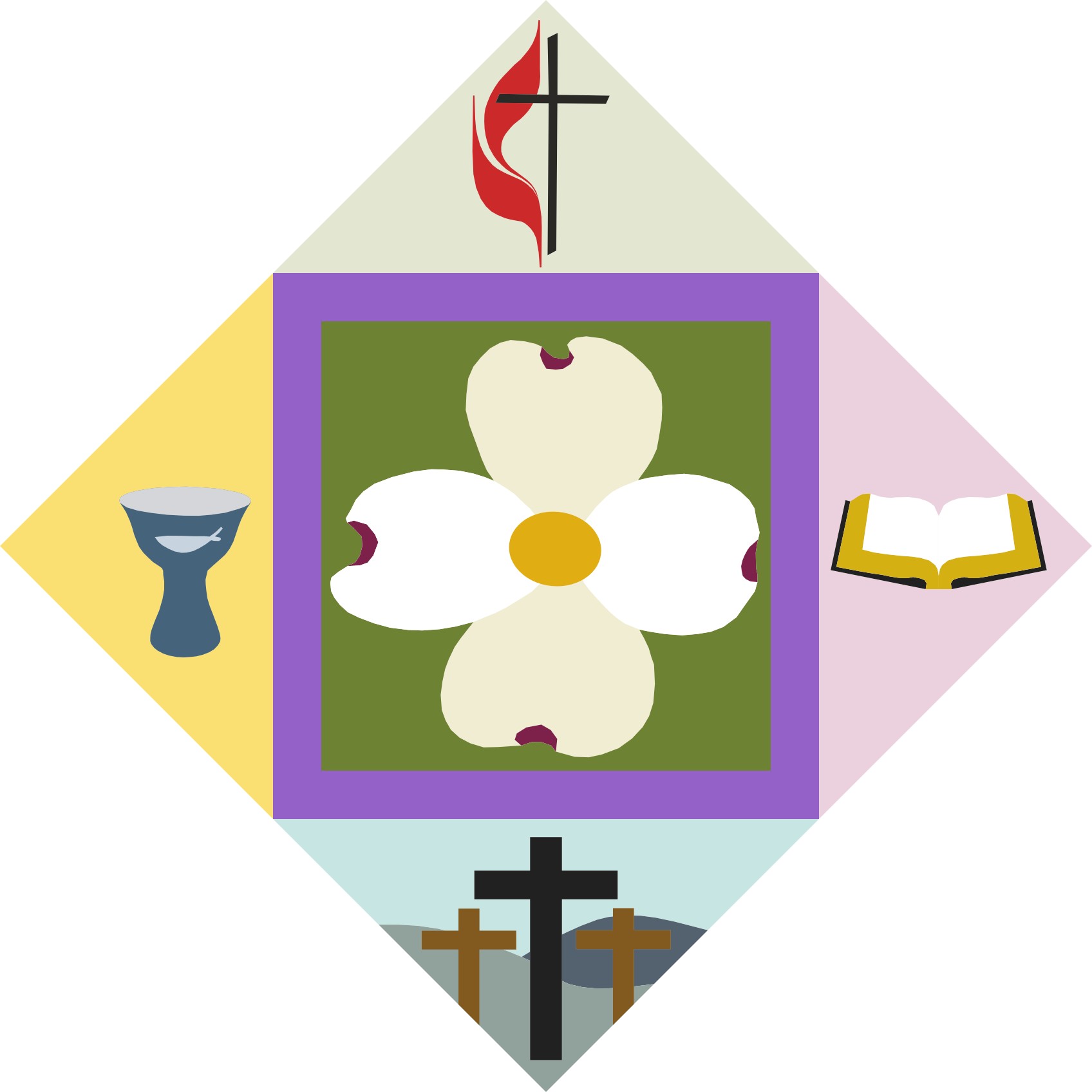Symbols of Our Faith
Block Number: 119
By Ginger Todd
“SYMBOLS OF OUR FAITH” BLOCK JOINS THE MCDOWELL QUILT TRAIL
St. Mark’s United Methodist Church had been considering hosting a block for some time, but it was near this past Easter that Linda Smith developed an idea for the design. Linda listened to Lynne Byrd, Choir Director and the children’s alternate teacher at the church, as she spoke to them about the symbolism of the Dogwood Tree and its blossom.
The Dogwood blossom is featured on the block for three reasons: its religious legend, the fact that it is the North Carolina flower and the significance it holds to Linda’s family. Her family roots are in Hilton Pottery first begun when John Wesley Hilton (1836-1923) returned from the Civil War. Passed on from generation to generation, today Bob Hilton continues the traditions and excellence of pottery creations. Linda’s grandmother, Clara Mande Cobb Hilton painted and sculpted pottery pieces, often including the incorporation of the Dogwood blossom. Another special reason that is given to the block is that Clara Hilton was a charter member of St. Mark’s Church.
The present building of St. Mark’s was built around fifty years ago, its motto being “open hearts, open minds, open doors”. The Pastor of the church for the past year, with approximately 80 in the congregation, is Julie Elliott O’Neal. There is a prayer garden behind the church, allowing for quiet reflection. A pottery chalice with the Christian image of a fish, sits gracefully on a communion table in front of the altar. Potter John Garrou of Black Mountain, made the chalice along with a matching pitcher and serving plate to be used for holy communion. The set was given to St. Mark’s in memory of his wife Becky’s mother Cora Moody, also Linda’s aunt.
This beautiful block, mounted on point (diagonally) features a white dogwood flower in the middle on a background of green surrounded by a purple border, representing royalty. The legend of the dogwood is that the tree was once tall and broad, making it the chosen wood to construct crosses. After the Crucifixion of Jesus Christ, it is said that God proclaimed that dogwood trees would never grow large again and permanently stunted their growth so they could not ever be used for that purpose.
In reality, Dogwoods don’t grow naturally in or near Israel however, many Christian traditions consider the flowers of the dogwood tree to be in the shape of a cross with two long and two shorter petals. The center tips of each petal have small dents in a faint brownish-rust color representing the blood-stained nail prints of the Crucifixion. The golden center of the flower symbolizes the crown of thorns worn by Jesus Christ. The showy blooms appear each year in Spring near the time of the Easter Season and the legend serves as meaningful reminder to Christians of that fateful weekend as well as the renewal of life.
It is interesting to note that the extremely hard wood of the Dogwood and its slender branches were ideal for the North American Indians to use. There is evidence they made daggers, arrows, tools and even knitting needles from the extremely durable and dense wood. Today the tree is popular for landscaping purposes.
Directly above the Dogwood bloom on the block is the traditional official symbol and insignia of the United Methodist Church, the Cross and Flame. The logo was adopted shortly after the merger of The Methodist Church and the Evangelical United Brethren Church in 1968 and was registered as a trademark in 1971. The single flame is a reminder of Pentecost, and the two tongues of the flame may also be understood to represent the union of the two denominations.
To the right of the Dogwood blossom is the Bible on a lilac background, the words of which are the Holy Gospel to Christians. At the bottom point of the block on a blue background are the three crosses, the larger one in the middle representing Christ, the smaller ones of the two rebels crucified along with Him on Mount Calvary.
The fourth point of the block to the left of center, on a background of bright yellow, is that of a grey chalice with the Christian fish on it similar to the one used in the church. The fish is mentioned several times in the Gospels and was used as a symbol during the persecution of ancient Christians by the Roman Empire. The symbol consists of two intersecting arcs, the ends of the right side extending beyond the meeting point, so as to resemble the profile of a fish. It was used to mark secret meeting places and also to identify who was Christian or who was not along the trail by drawing one side in the dirt and see if the other person completed it.
The 4’ X 4’ block #119 on the trail, was installed on the front brick wall of the church to the right of the entrance on June 25, 2012 by Quilt Trail volunteers Mike Lucas and Alan Scholl. It may be viewed at 3149 Highway 70 North. The block “Symbols of Our Faith” is a gift to the church from Linda (a member of the McDowell Quilt Trail Committee) and her husband Bobby Smith, in memory and honor of all who have made the St Mark’s Church such a warm and welcome house of God. Volunteer Jill Lucas presented the Certificate of Authenticity to Pastor O’Neal along with Bill and Linda Smith.
